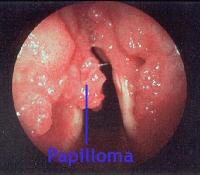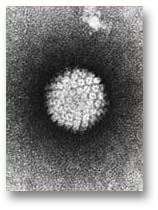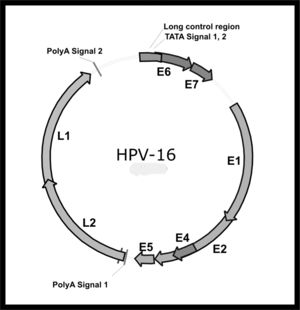Recurrent respiratory Papillomatosis current trends
Contents
Introduction:
Recurrent respiratory papillomatosis is a disorder of viral origin. It is associated with multiple exophytic lesions present in the airway. It is a benign disorder, but can cause airway complications with risk of malignant conversion. This disease is difficult to treat because of its tendency to recur. Some patients may experience spontaneous regression of the disease, while others may suffer from aggressive papillomatous growth requiring multiple surgical interventions. The reasons for this extremes in behaviour are not clearly understood.
Etiology:
Human papilloma virus has been attributed as the causative organism. Viral particles have never been consistently demonstrated in the papilloma lesions even with electron microscopy. Use of viral probes have demonstrated papilloma virus DNA in all the papilloma lesions studied.
Human papilloma virus: is a small DNA containing non enveloped icosahedral (20 sided) capsid virus. The DNA is double stranded and circular.
Depending on viral genetics 100 different types of human papilloma viruses have been identified. Among the types affecting the aerodigestive and genital tracts human papilloma virus types 6 and 11 have been associated with the lowest malignant potential, where as human papilloma virus types 16 and 18 have the greatest malignant potential. Children infected with human papilloma virus 11 have more obstructive airway early in the disease.
The human papilloma virus infects the basal layer of the mucosa. The viral DNA enters the cells and gets transcribed into RNA. This RNA is translated into viral proteins. After infection the viral DNA can either be actively expressed or can exist as latent infection in the mucosa. In latent infections the mucosa remains clinically and histologically normal. During latency, very little viral RNA is present inside the cells. Reactivation of the virus can occur at any time leading to symptoms.
The viral genome has 3 regions:
1. The upstream regulatory region
2. E region / Early region: The E genes are involved in oncogenes responsible for active replication of the viral genome.
3. L region / Late region genes encode viral structural proteins.
Human papilloma virus must have a means to reactivate the necessary host replication genes to facilitate its own DNA replication. One growth factor known to be associated with proliferation of epithelial cells is the epidermal growth factor receptor. Papilloma virus induce epithelial proliferation by increasing the level of expression of epidermal growth factor or its ligands. It may also increase cell proliferation by interacting with p53 or other tumor suppressor proteins inhibiting their normal functioning.
Host immune plays an important role in the pathogenesis of papilloma virus infections. The patient's immunocompetence may influence the clinical course of the disease. Both humoral and cellular immune responses may be compromised in children with recurrent respiratory papillomatosis.
Epidemiology:
Recurrent respiratory papillomatosis may have its clinical onset either during childhood or adulthood. Juvenile onset respiratory papilloma is more aggressive, and adult onset disease may be little bit less aggressive. In children recurrent respiratory papillomatosis is the most common benign neoplasm of the larynx.
Incidence may be very variable ranging from 2 - 3 / 100,000 population. Observations suggest that most of these patients are first born child to young primi gravida mothers. Primi gravida mothers are more prone for prolonged second stage of labor causing increased exposure to the virus. It is common in patients among low socioeconomic status. It is worthwhile to aggressively manage genital papillomatous infections to prevent vertical transmission of the infection from mother to child.
Transmission:
The mode of transmission of human papilloma virus is unclear. Studies have demonstrated the link between childhood onset recurrent respiratory papillomatosis to mothers with genital papilloma virus infections; in adults evidence suggests that it could be associated with oro genital contact.
Histology:
It appears as sessile or pedunculated masses. It may be pink or whitish in color. The masses consist of finger like projections of non keratinised stratified squamous epithelium supported by a core of highly vascularised connective tissue stroma. The basal layer may be either normal or hyperplastic and mitosis is generally limited to this layer.
Surgical:
Microlaryngeal excision of the lesion is performed. Laser excision is preferred in recurrent cases, and for cases where tracheal mucosa is involved.
Adjuvant treatment: Most commonly adopted criteria for initiating adjuvant therapy is the requirement of more than 4 surgical procedures during a calender year, distal multispread of disease.
Cidofovir: is a nucleoside analog that has antiviral activity against herpes family of virus. This drug has been shown to induce apoptosis in human papilloma virus infected cells.
Interferons: are manufactured by cells in response to a variety of stimuli, including viral infection. Interferons when administered produce a blocking effect on viral replication of RNA and DNA. It also alters the cell membrane causing it become impervious to viral penetration. Hence interferon can be adminstered as adjuvant.
Side effects of interferons include:
1. Flu like symptoms
2. Decreased growth rate of child
3. Leukopenia
4. Spastic diplegia
5. Thrombocytopenia
6. Alopecia
7. Pruritus
8. Fatigue
Photodynamic therapy:
Is based on the transfer of energy to a photosensitive drug. The drug used is dihematoporphyrin ether (DHE). This drug has a tendency to concentrate within papillomas more than in surrounding normal tissue. Patients are typically treated intravenously with 4.25mg /kg of DHE before photoactivation with an argon pump dye laser.
Ribavirin: is an antiviral drug used to treat pneumonia in infants caused by respiratory syncytial virus has shown some promise in the treatment of aggressive papillomatosis.



